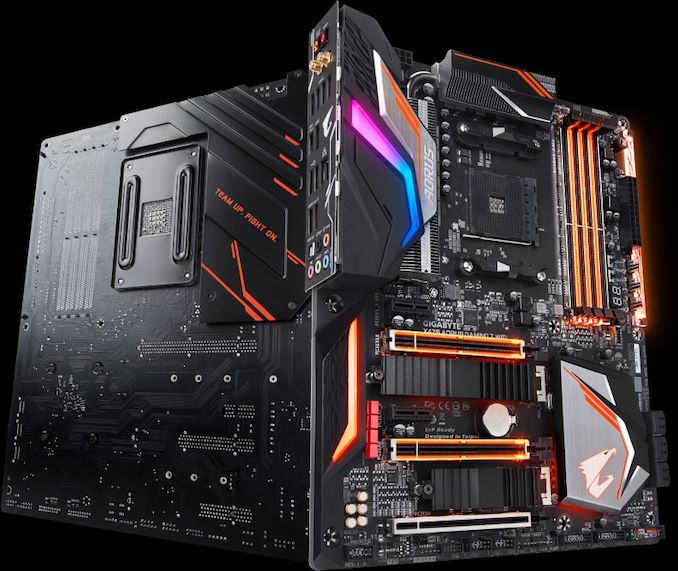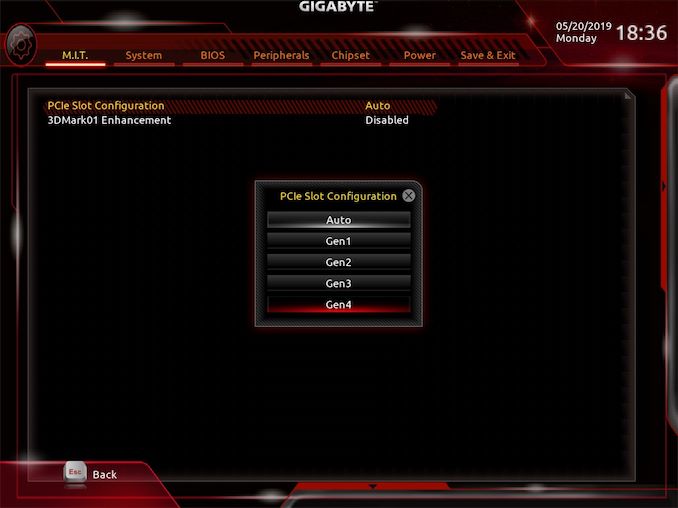GIGABYTE AM4 Motherboards: PCIe 4.0 Ready for Ryzen 3000
by Gavin Bonshor on May 21, 2019 11:00 AM EST
In preparation for the launch of AMD's next generation of Ryzen processors, GIGABYTE has released a wave of firmware updates for its X470 and B450 AM4 socket motherboards. The new firmware adds listed support for AMD's Ryzen 3000 series (Matisse) processors prior to launch.
GIGABYTE has launched its own firmware updates offering users support AMD's upcoming Ryzen 3000 series processors. This not only means users can use their existing AM4 motherboards with the upcoming CPUs when they launch later this year, but upon some investigation with a GIGABYTE X470 Gaming 7 Wi-Fi motherboard we had in the lab, I flashed it to the latest F40 firmware update, and found that PCIe 4.0 could be set within the PCIe slot configurator.
 GIGABYTE X470 Gaming 7 Wi-Fi running the latest F40 firmware confirms some PCIe 4.0 support
GIGABYTE X470 Gaming 7 Wi-Fi running the latest F40 firmware confirms some PCIe 4.0 support
While there is no official confirmation from GIGABYTE itself (or from any of the other vendors for that fact), PCIe 4.0 support on current generation AM4 motherboards will be done on a model by model basis. Back at CES 2019, we confirmed that AMD's 3000 series CPUs would become the world's first mainstream CPU to support PCIe 4.0 x16. However, PCIe 4.0 support on current motherboards in the market will depend on how they are built: PCIe 4.0 specifications state that traces should be under a minimum length, and any longer requires a PCIe 4.0 redriver to boost the signal further down the board. Due to this, it is probable, but not confirmed that some existing X370, B350, X470 and B450 models may not offer the full capacity of PCIe 4.0 that Ryzen 3000 is expected to see when it is launched in the coming months.
As there is a lot of speculation around AMD's Ryzen 3000 series, X570, and which current generation AM4 motherboards will support the new PCIe 4.0 interface, it's clear that it will feature in some capacity. In what capacity exactly is currently unknown. Given the limitations, PCIe 4.0 might be limited to the top slot on most motherboards. Without existing redrivers on the lower located slots of ATX sized AM4 models, it wouldn't actually be possible to benefit from PCIe 4.0 with the distance restriction in play for an effective signal. This would mean that the top slot could operate at PCIe 4.0, whereas each of the other slots below would be locked down to PCIe 3.0 by default. Obviously new X570 boards will be built with this in mind.
The wave of F40 firmware updates can be downloaded from the relative product pages of each of the current GIGABYTE B450 and X470 models. GIGABYTE has also made us aware that we can expect similar firmware updates for its B350 and X370 models at the end of the month.
Related Reading
- The GIGABYTE X470 Gaming 7 Wi-Fi Motherboard Review: The AM4 Aorus Flagship
- AMD Ryzen 3rd Gen 'Matisse' Coming Mid 2019: Eight Core Zen 2 with PCIe 4.0 on Desktop
- AMD Reiterates 7nm Roadmap: Navi, Matisse, & Rome to Launch in Q3
- AMD to Host "Next Horizon Gaming" Event & Product Unveil at E3 2019: June 10th, 3pm PT
- Analyzing B450 for AMD Ryzen: A Quick Look at 25+ Motherboards
Source: GIGABYTE










32 Comments
View All Comments
Qasar - Wednesday, May 22, 2019 - link
peevee,i think you are over thinking this.. there has been tests done, i think even AT has done a few, most of the consumer software we use.. in not memory limited, after use of ram passed a certain speed, and latency, there is very little difference, so your thoughts on how wide the bus is, 128 bits or 64 bits.. has little effect, except when there is an IGP envolved, as seen here : https://www.anandtech.com/show/7364/memory-scaling... im sure you would be able to find more if you looked....
Valantar - Tuesday, May 21, 2019 - link
Adding memory channels dramatically increases motherboard costs (due to more layers being needed to route the traces), which isn't tenable for a mainstream platform. Just compare the cheapest TR4 or 2011 motherboards to the cheapest AM4 or 1151 ones. Also, instead of a wider bus we have dramatically increased memory transfer rates, which DDR5 will again give a massive boost (2x for the mainstream). It hasn't increased proportionally to CPU performance, of course not, but there are extremely few applications that are memory bound on modern PCs. iGPU gaming is pretty much the only common one.peevee - Wednesday, May 22, 2019 - link
I don't think the current physical location of DIMM slots is good. I'd prefer to have 4 slots on 4 sides of CPU, each as close as possible to reduce latency and power. The best would be the slots literally on the sides of CPU socket, with contacts not even touching the board. Then the board itself can be 1-layer, simple and cheap.HStewart - Tuesday, May 21, 2019 - link
I be a little concern on first generation PCIe 4.0 support. Is 100% backwards compatible with PCIe 3.0. It might better to wait until more products are out.phoenix_rizzen - Tuesday, May 21, 2019 - link
Aww, are you upset that AMD might ship PCIe 4.0 before your pet Intel does?imaheadcase - Tuesday, May 21, 2019 - link
Are you high right now or something, no one was even mentioning Intel.GreenReaper - Tuesday, May 21, 2019 - link
No, he's not high, he's just assuming that HStewart is bring pro-Intel and casually dissuading purchase of a product related to AMD. Of course if it turns out that Intel is actually first to market, PCIe 4.0 will suddenly be 100% reliable and there will be no reason to buy obsolete hardware. ;-pSantoval - Wednesday, May 22, 2019 - link
Intel first to market with what, PCIe 4.0 support? This looks highly unlikely. On the other hand Intel has not yet announced, to my knowledge, if Ice Lake-U and -Y CPUs will have PCIe 4.0 controllers (their mid power -H and high power -S Ice Lake CPUs are apparently being pulled back deep into 2020 or even 2021...). Could their Sunny Lake cores support PCIe 4.0 from top to bottom? Maybe. Or maybe not, this *is* Intel after all. Still, debuting PCIe 4.0 in laptops and ultraportables seems way too bold and implausible to me.DanNeely - Wednesday, May 22, 2019 - link
A just leaked Xeon roadmap has Icelake with PCIe4 in 2020q2, and Saphire Rapids with DDR5 and PCIe5 in 2021q1.No idea if the corresponding consumer platforms will maintain IO parity with the server ones. I'd rank PCIe4 as most likely just to mitigate the impact of AMD first; DDR5 in the middle, with delaying a year if the price premium is too high as plausible; and PCIe5 as least likely. Very short maximum trace lengths without repeaters or mobo tech that would massively increase board prices lean towards confirming prior speculation that PCIe5 would be a server only tech.
https://wccftech.com/intel-xeon-roadmap-leak-10nm-...
https://www.eetasia.com/news/article/18061502-pcie...
HStewart - Wednesday, May 22, 2019 - link
This would be same as Intel came out with PCIe 4.0, will it be backwards compatible and what about PCIe 5.0 coming out a year.I have old Xeon 5160, it was a pain to get a graphics card for because makers stop making cards for what I believe is PCIe 2.0 at the time.